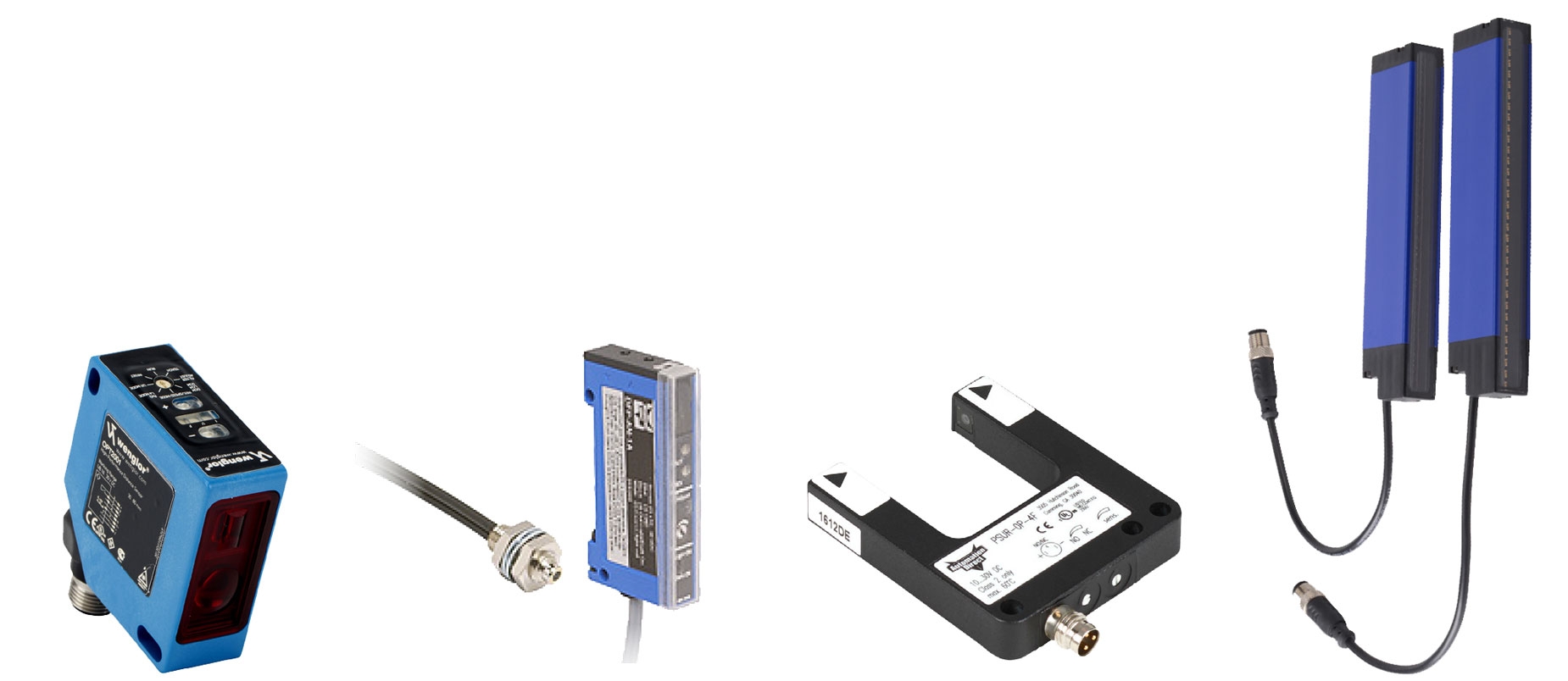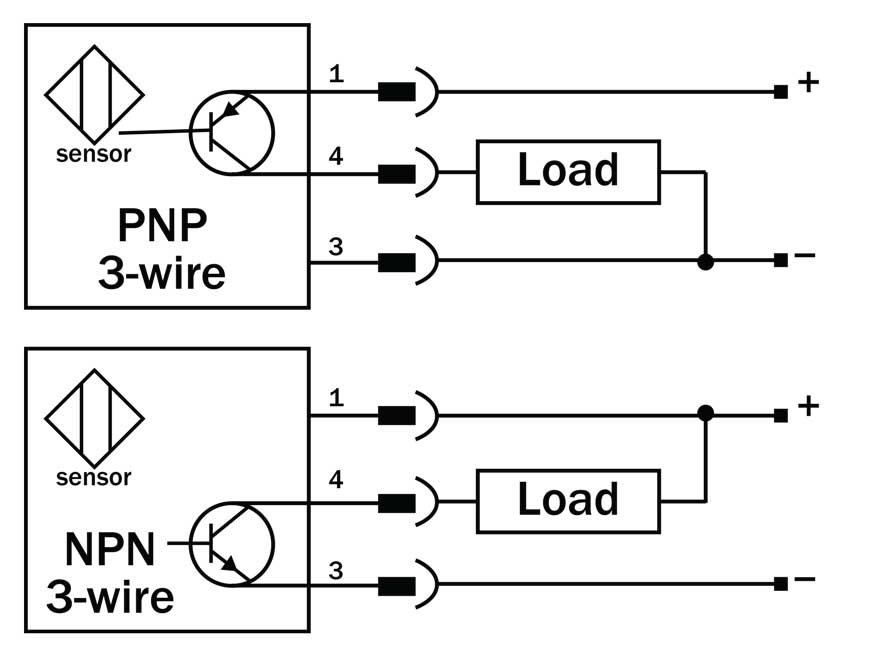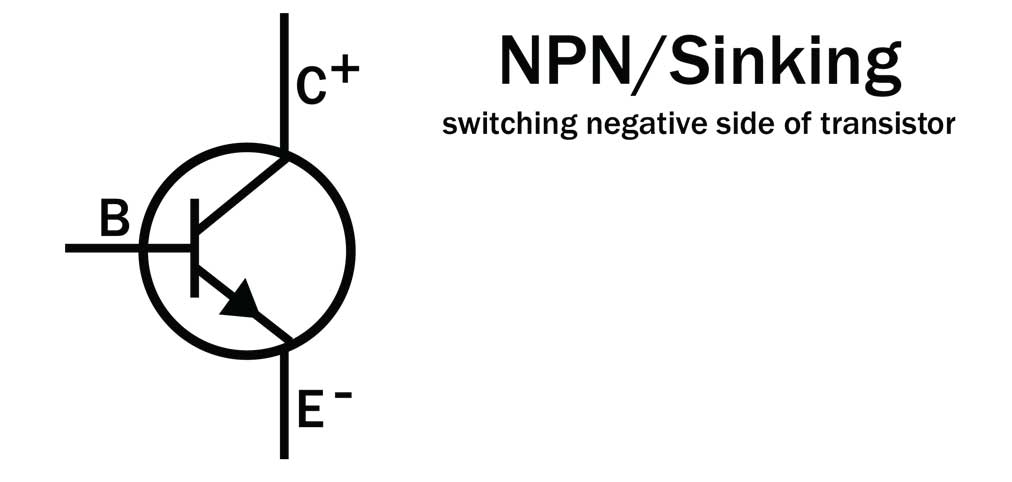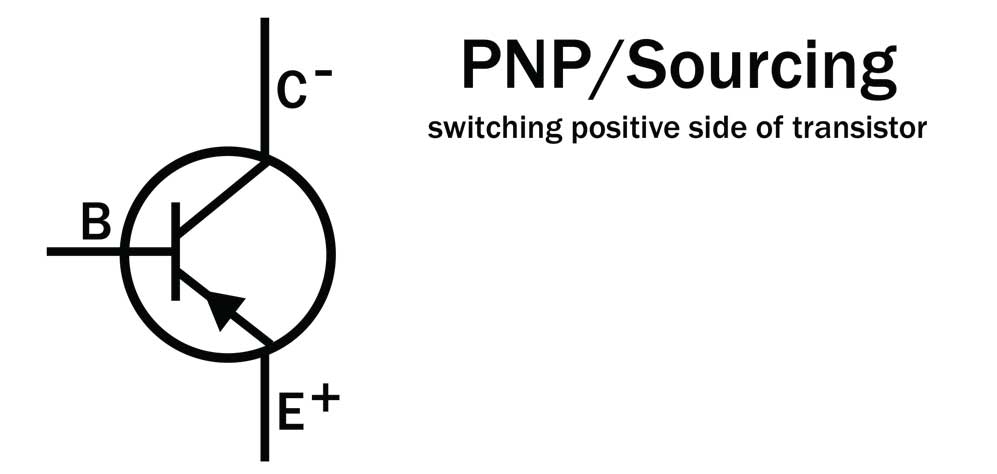You have no items in your shopping cart.
Sensors- An Overview of the Basics

Practical Guide to
Discrete Sensors for Industrial Applications
CHAPTERS 1 & 2
Introduction to Different Types of Discrete, Object Detection Sensors
There are many types of object detection sensors available on the market. Some of them, such as limit switches, require direct contact with the object. Others, such as proximity sensors, need to be in close physical range but do not make contact with the object. Still others can detect objects from much further distances; examples include photoelectric, laser and ultrasonic sensors.

Limit Switches
Limit switches are one of the most common object detection sensors used in industrial controls. They are energized when an object makes physical contact with the actuator. Theynormally provide an electromechanical contact closure, but some also move a pneumatic valve. There are many different form factors and actuator styles to choose from.
Inductive Proximity Sensors
Inductive proximity sensors detect the presence of metallic objects at close range (under 1.5inches typically). Ferrous metals allow the greatest distances to the sensor; other metals may reduce detection range.
Magnetic Proximity Sensors
Magnetic proximity sensors are used for non-contact object detection beyond the normal limits of inductive sensors. Used with a separate damping magnet, they offer very long sensing ranges in a small package and can detect magnets through walls of non-ferrous metal, stainless steel, aluminum, plastic or wood.
Capacitive Proximity Sensors
Capacitive proximity sensors use a dielectric plate generating an electrostatic field to detect both metal and non-metal objects and can sense through insulating materials such as wood or plastic. They are often used to detect fill levels of liquids, pellets, and powders through container walls. Capacitive sensors are available in cylindrical or rectangular shapes, with sensing distances typically up to 40mm.
Photoelectric Sensors
Photoelectric sensors use reflected or detected light waves to detect object presence or distance in a wide range of industrial applications. They typically contain all required optics and electronics in a single unit, requiring only power to provide an output based on their specifications and object detection criteria. Photoelectric sensors can detect a wide variety of materials and have extended sensing ranges.
Specialty Sensors
Other object detection sensors are available for specialized applications. Some specialty sensors available that work similarly to a photoelectric sensor are laser sensors, fiber optic sensors, fork sensors, and area sensors. Although not seen as often as other types of sensors in the automation industry, they can be vital to an application with unique needs.

Common Terms Used For Discrete Sensors
Sensors have many different options when it comes to the output signal. The output can be an electromechanical relay contact or it can be solid state. If it is a solid state output, then the logic can be NPN or PNP. Either type of output can be Normally Open or Normally Closed.
Electromechanical Relay Contact vs. Solid State Output
An electromechanical relay output uses a physical set of contacts that open or close to switch a signal. This works very similarly to a light switch in your house. It is either fully open or fully closed. The advantages of a relay contact output are that the signal is either fully ON or fully OFF and this type of output circuit usually can handle much higher current draw through it. A drawback of a relay contact is that since it is mechanical, it will eventually wear out after extended use and either weld closed or be stuck open. Most limit switches offer this as their output circuit type, although some other sensors may have this as an option as well.
A solid-state output uses a purely electrical device to switch the output signal. An example of a solid state device would be a transistor, MOSFET, SCR, or Triac. Solid state devices use no moving or mechanical parts and essentially have an infinite lifespan if they are not overloaded. They are smaller than relay contacts and make no noise when switching the output signal. Some drawbacks to solid state devices are that they usually do not handle as much current as a relay contact, and they are never truly completely OFF or completely ON so they will have some leakage current in their OFF or open state.
NPN vs. PNP or Sink vs. Source
For DC solid state outputs, an important consideration to take into account is whether the logic of the sensor output needs to be NPN or PNP
(other terms to describe the same logic is sinking versus sourcing). To properly wire your control device, you need to first know whether the sensor you are using is switching the positive or negative connection. For AC (alternating current) sensors, this is not an issue since AC power alternates its polarity 120 times per second with 60-hertz current and AC sensors are designed for that. On the other hand, DC (direct current) sensors only allow current flow in one direction and therefore have a constant polarity that must be considered.
With DC sensors, NPN and PNP may be terms you hear quite often. These terms define the Collector, Base and Emitter polarities of the transistor itself. In these transistors, the ON and OFF switching is accomplished between the Collector and Emitter legs, and the Base (controlled by the sensor) will determine when that happens. How the transistor closes the control circuit will determine if it’s a sinking or sourcing output.

NPN
For an NPN transistor, when a positive polarity of sufficient voltage is applied to the Base, a small current will flow across the Base-to-Emitter junction. This small current opens the path for a larger positive current from the Collector to flow to the negative Emitter. In this case, when the transistor’s Collector-to-Emitter junction closes, it is effectively a switch completing the circuit on the negative side of the load. In other words, the transistor is sinking the supplied current flowing through the control device.

PNP
With a PNP transistor, once a negative polarity of sufficient voltage is applied to the Base, a small current flows across the Emitter-to- Base junction. This small current opens the path for the Emitter’s positive current to flow to the negative Collector. In this case, when the transistor’s Emitter-to-Collector junction closes, it is effectively a switch completing the circuit on the positive side of the load. In other words, the transistor is sourcing the supplied current flowing to the control device.

It is important to select the correct logic for your sensor depending on the device to which it is sending its signal. Many DC sensors today include both types of transistors, so you can easily match them to the control device you are using.
AC (Alternating Current) Solid State Outputs
Some sensors support an AC solid state output. The solid-state device used for an AC solid state output is usually a triac. As mentioned above, you do not need to worry about NPN/PNP or sinking/sourcing with an AC solid state output since the direction of current is changing anyway. Triacs are fast responding, make no noise when switching and never wear out. Drawbacks are that they have lower current switching ratings than electromechanical relays and they tend to have higher leakage currents than DC transistors.
Normally Open vs. Normally Closed (NO/NC)
Normally open versus normally closed are terms used to describe whether the output is ON or OFF based on the sensor’s normal state. This is a throwback term from when the only output option was a relay contact and solid state switches didn’t exist. However, today we use the same terms to describe solid-state or relay outputs.
If the output is described as being closed, then the output is ON, just like when a relay contact or light switch is closed the output will be ON. When an output is described as being open then the output is OFF, exactly the opposite of being closed.
The “normal” state of a sensor means that the sensor is not detecting an object.
So for example, if any type of sensor has a normally open output and it does not detect an object, then the output will be OFF and will turn ON when it detects an object.
Likewise, if a sensor has a normally closed output, the output will be ON when it does NOT detect an object and the output will then turn OFF when an object is detected.
Environmental Ratings
All sensors offer some degree of protection from environmental factors such as moisture and debris. Ingress Protection (IP) ratings are established by the IEC and define the protection offered by electrical devices and their enclosures. It is similar to the NEMA rating system. IP ratings of IP65 or higher are very common for most sensors. Harsh duty models are also available and can have ratings as high as IP69K. IP69K is often required in the food and beverage industry where the sensors must withstand “washdown” cleaning procedures, often with harsh chemicals.
Connection options
Sensors may offer a threaded conduit fitting, an attached (embedded) cable or a quick-disconnect (Q/D) fitting to which a mating cable can be attached.
Threaded conduit connection- On many limit switches, the connection is a threaded conduit connection opening in which individual wires can be terminated. Usually, this is either a female NPT or female PG threaded connection.
Attached cables- Attached cables (embedded) are typically 6 feet (2m) in length and are molded into the body of the sensor at the attachment point. They are typically the less-expensive option. The cable can be cut to length, or may not be long enough to reach all the way to the termination point controller. Field junction boxes may be required, and numerous sensor signals are often combined into multi-conductor cables at such junction points. Lastly, a cable exiting from the end of the sensor body may not fit (physically) in all applications.
Quick-disconnects- Sensors with quick disconnect fittings require the use of a separate cable to complete the installation. These cables typically include industry-standard M8, M12, or micro-AC (for some AC powered sensors) style connections on one end and offer a pigtail (flying leads) on the other end for completing the connection. These quick-disconnects offer several advantages: it’s very easy to replace a damaged sensor without any rewiring, and the cables are available in longer lengths with axial or 90-degree connections at the sensor. Field-wireable quick-disconnect connectors are also available for constructing custom cables.
Thanks for reading. This article is courtesy of AutomationDirect.com and has been adapted from Chapters 1 &2 of their ebook 'Sensors: Practical Guide to Discrete Sensors for Industrial Applications'.
Browse our complete range of sensors here. Need help choosing the right sensor for your application? Give our technical support team a call.


